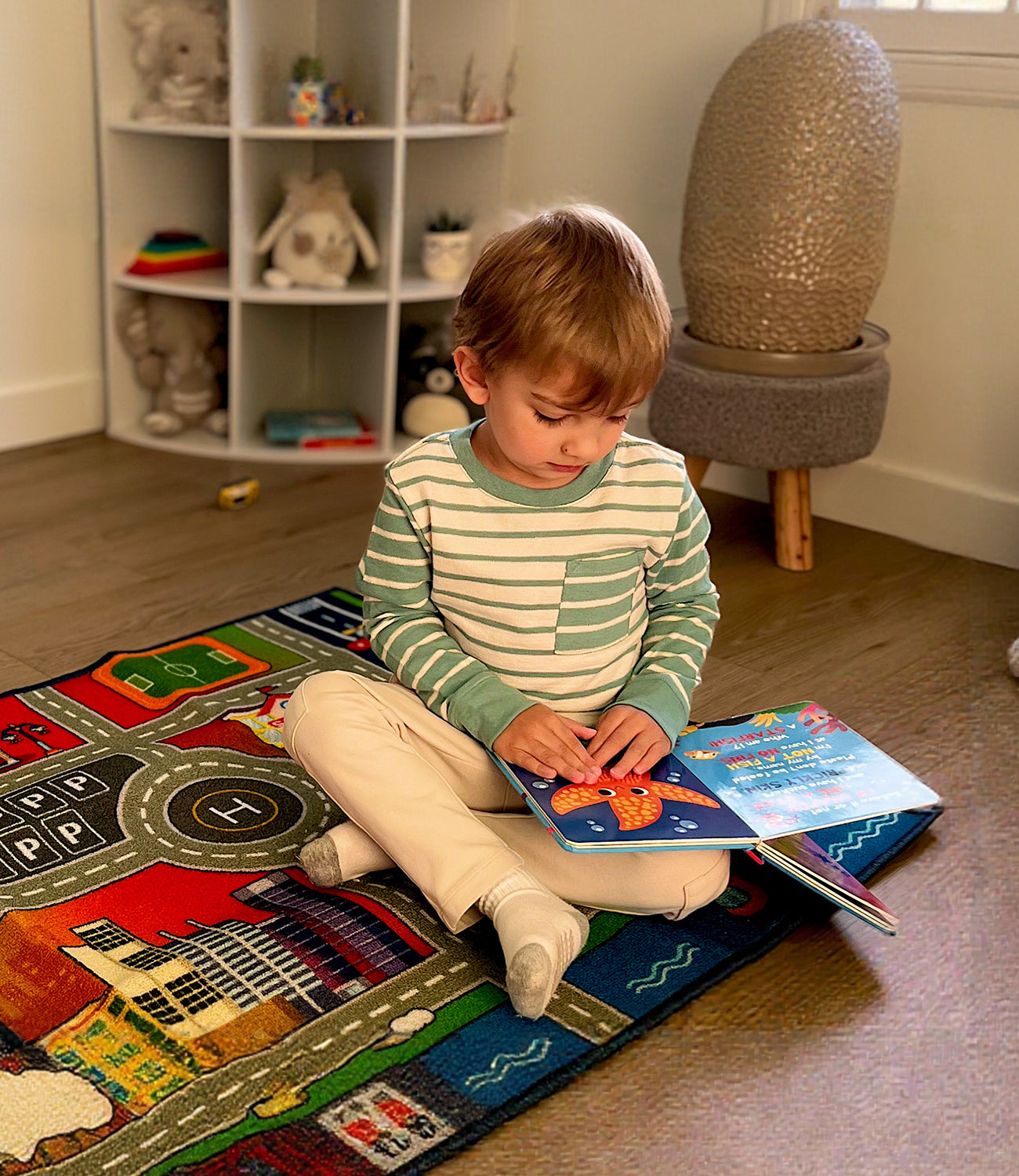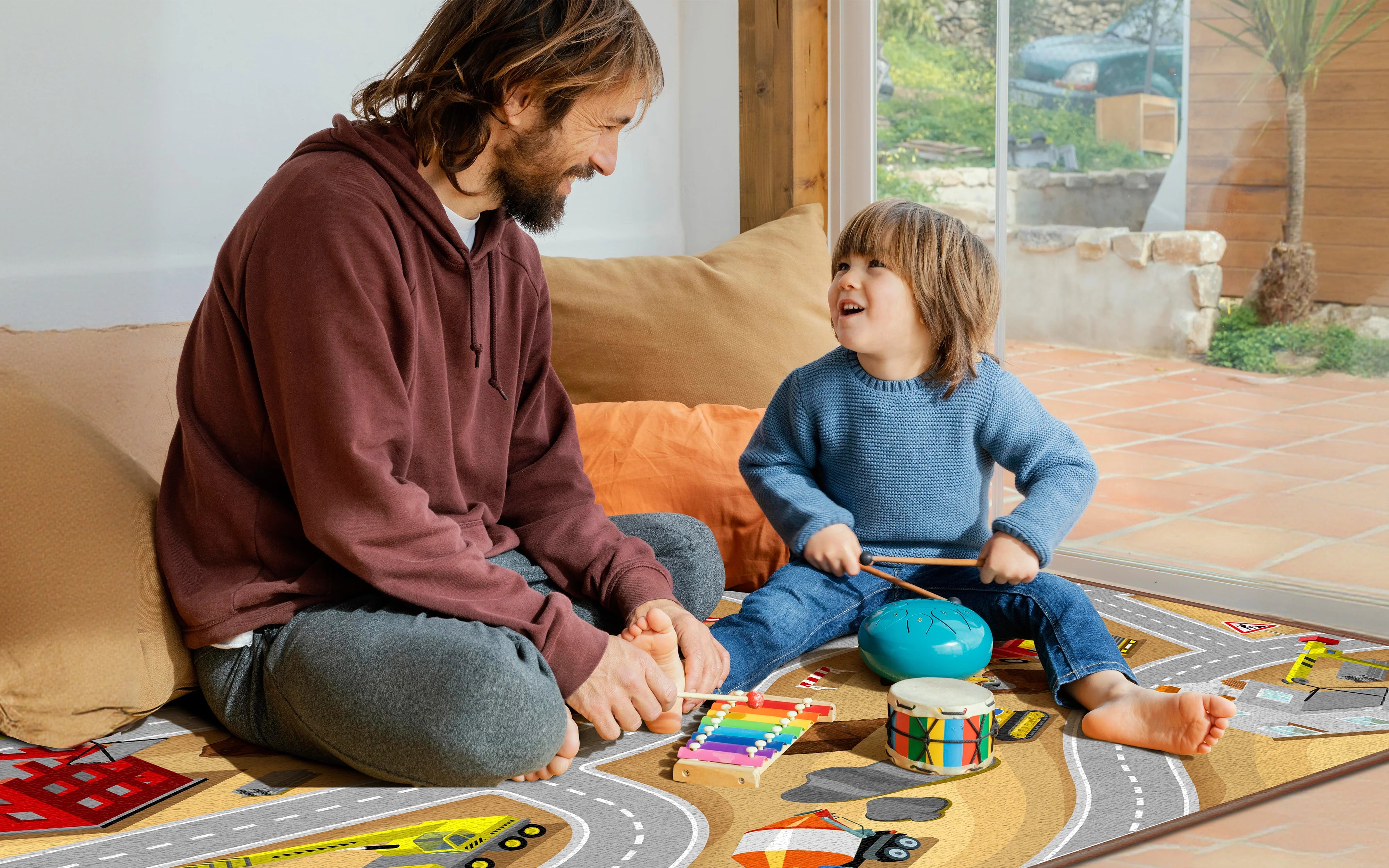The Critical Role of Material Selection in Classroom Safety
When selecting classroom rugs, the choice of material goes far beyond aesthetics—it's fundamentally about creating a safe, healthy learning environment where children can thrive.
Research from pediatric occupational therapy demonstrates that children engage in 37% longer periods of sustained attention when positioned on appropriately cushioned surfaces versus hard flooring, making material selection a crucial factor in educational outcomes.
Understanding Safety Standards: ASTM and CPSC Requirements
All carpets and rugs manufactured, imported, or sold in the United States must meet flammability standards under 16 CFR parts 1630 and 1631, while children's products must comply with additional lead content requirements and CPSC safety standards.
These regulations ensure that classroom rugs meet stringent safety criteria for fire resistance, chemical safety, and structural integrity.
At Booooom Jackson, safety isn't just about meeting minimum requirements—it's about exceeding them.
Our rigorous testing process ensures that every rug provides a secure foundation for learning activities, from circle time discussions to interactive play sessions.
Cotton vs. Wool vs. Synthetic: Material Comparison for Classroom Use
Cotton: The Washable Champion
Cotton classroom rugs offer excellent washability, making them ideal for high-traffic educational environments where spills and accidents are common. The natural fiber composition provides:
- Easy maintenance: Machine washable properties for quick cleanup
- Breathability: Natural airflow that helps prevent moisture buildup
- Softness: Comfortable surface for extended floor activities
- Hypoallergenic properties: Reduced risk of allergic reactions
However, cotton rugs may require more frequent replacement due to wear patterns and can be susceptible to shrinkage with repeated washing.
Wool: Natural Durability and Comfort
Wool represents the premium choice for long-term classroom investments, offering:
- Exceptional durability: Natural resilience that withstands years of classroom use
- Stain resistance: Natural lanolin provides inherent protection against spills
- Fire resistance: Wool's natural flame-retardant properties exceed synthetic alternatives
- Temperature regulation: Insulating properties that provide comfort year-round
The main considerations with wool include higher initial costs and specialized cleaning requirements that may challenge school maintenance protocols.
Synthetic Materials: The Modern Solution
Contemporary synthetic classroom rugs, particularly those crafted from high-quality nylon and polyester blends, offer compelling advantages for modern educational settings:
- Superior stain resistance: Advanced fiber treatments repel liquids and resist permanent staining
- Antimicrobial properties: Built-in protection against bacteria, mold, and mildew growth
- Consistent performance: Predictable wear patterns and maintenance requirements
- Cost effectiveness: Lower initial investment with excellent longevity
Booooom Jackson's durable nylon fibers resist fading, with reinforced edges that prevent fraying and weighted bottoms that increase slip resistance by 80%, making our large classroom rugs ideal for high-traffic classroom environments.
Safety Features That Matter in Educational Settings
Non-Slip Technology and Physical Safety
Using non-slip rug pads helps keep rugs securely in place, with effective pads decreasing slip incidents by up to 50% according to ASTM research.
Booooom Jackson rugs feature integrated slip-resistant backing that eliminates the need for additional safety measures while providing stability during active learning sessions.
Key safety features include:
- Weighted backing systems that prevent rug movement during activities
- Reinforced edge construction that eliminates trip hazards
- Low-pile design that accommodates wheelchairs and mobility aids
- Beveled edges that create smooth transitions from floor to rug surface
Chemical Safety and Indoor Air Quality
Modern parents and educators rightfully prioritize indoor air quality and chemical exposure concerns.
Booooom Jackson rugs are made with non-toxic, eco-friendly materials free from PVC, phthalates, and lead, ensuring that classroom environments remain healthy for developing children.
Essential chemical safety considerations include:
- Volatile Organic Compound (VOC) emissions: Choose rugs with low or zero VOC emissions
- Phthalate-free construction: Avoid plasticizers that may impact hormonal development
- Lead-free materials: Critical for preventing developmental exposure risks
- Formaldehyde-free adhesives: Important for maintaining healthy indoor air quality
Acoustic Benefits for Learning Environments
Strategic placement of dense classroom rugs, such as a plush reading rug in a quiet corner, can improve classroom acoustics by 7-10 decibels, particularly benefiting students with auditory processing challenges and those learning English as a second language.
This acoustic improvement creates environments where instruction can be clearly heard and understood by all students.
Educational Design Elements That Enhance Learning
Curriculum-Integrated Patterns
Today's educationally designed rugs incorporate specific learning standards directly into their patterns, with mathematical classroom carpets featuring coordinate grids and number lines that align with spatial reasoning standards.
Booooom Jackson's educational classroom rugs transform passive floor space into interactive teaching tools.
Popular educational design elements include:
- Alphabet and phonics integration for early literacy development
- Number lines and geometric patterns for mathematical concept reinforcement
- Color-coded seating areas that facilitate group organization and management
- Geographic elements that support social studies curriculum objectives
Sensory-Friendly Design Considerations
For neurodiverse children, especially those with sensory processing differences, ADHD, or autism, the surface beneath them can make a world of difference in how they experience learning.
Thoughtful rug design supports inclusive education by accommodating diverse sensory needs.
Sensory-friendly features include:
- Varied textures that provide tactile feedback without overwhelming sensitive systems
- Visual organization with clear boundaries that help children understand positioning
- Soothing color palettes often seen in pastel classroom rugs, that avoid overly bright combinations that trigger sensory overwhelm
- Defined personal spaces that support children who struggle with spatial boundaries
Maintenance and Longevity: Practical Considerations
Easy Cleaning Protocols
Booooom Jackson rugs can be easily cleaned with a regular vacuum cleaner with no special equipment needed, simplifying maintenance protocols for busy educational facilities.
Effective cleaning procedures preserve both appearance and hygiene:
Daily maintenance:
- Regular vacuuming to remove surface debris and allergens
- Immediate spot cleaning of spills to prevent permanent staining
- Rotation of high-traffic areas to ensure even wear patterns
Deep cleaning:
- Quarterly professional cleaning or machine washing as appropriate
- Antimicrobial treatments to maintain hygienic conditions
- Thorough drying to prevent mold and mildew development
Cost-Effectiveness Over Time
When evaluating classroom rug investments, consider total cost of ownership rather than initial purchase price. High-quality rugs with superior materials and construction provide better value through:
- Extended lifespan that reduces replacement frequency
- Maintained appearance that preserves classroom aesthetics
- Consistent performance that eliminates unexpected maintenance costs
- Educational value that supports curriculum objectives over multiple school years
Age-Appropriate Selection Guidelines
Early Childhood (Ages 2-5)
Preschool and early elementary classrooms require rugs that accommodate developmental needs:
- Larger individual spaces for developing spatial awareness
- High-contrast colors found in colorful classroom rugs that support visual development
- Soft pile construction that cushions frequent floor activities
- Washable materials that handle inevitable accidents gracefully
Elementary Age (Ages 6-11)
School-age children benefit from rugs that support more complex learning activities:
- Defined seating arrangements on classroom seating rugs that facilitate group discussions
- Educational content integration that reinforces academic concepts
- Durable construction that withstands active use patterns
- Flexible design that accommodates various classroom configurations
Special Considerations for Inclusive Classrooms
Supporting Children with Allergies and Asthma
Booooom Jackson rugs are hypoallergenic and resist dust mites, mold, and mildew, making them perfect for kids with allergies or asthma. Creating allergen-free learning environments requires careful material selection and maintenance protocols.
Key considerations include:
- Hypoallergenic fibers that minimize allergic reactions
- Antimicrobial treatments that prevent bacterial and fungal growth
- Low-pile construction that facilitates thorough cleaning
- Moisture resistance that prevents mold development in humid conditions
Accommodating Mobility Needs
Inclusive classrooms must consider students with various mobility requirements:
- Smooth transitions between flooring surfaces
- Stable positioning that accommodates wheelchairs and mobility devices
- Clear pathways that maintain accessibility throughout the classroom
- Non-slip surfaces that provide security for all mobility levels
Making the Right Choice for Your Classroom
Assessment Criteria
When selecting classroom rugs, evaluate options based on:
- Safety compliance with relevant standards and regulations
- Material quality and expected lifespan under classroom conditions
- Educational value and curriculum integration opportunities
- Maintenance requirements and cleaning protocols
- Budget considerations including total cost of ownership
- Student population needs and inclusive design requirements
Booooom Jackson's Commitment to Educational Excellence
With over 10 years of specialization in children's classroom rugs, Booooom Jackson combines safety, durability, and educational value in every product.
Our original designs undergo rigorous quality control to ensure that educators receive products that support both immediate classroom needs and long-term educational objectives.
Conclusion: Investing in Safe, Educational Floor Coverings
The selection of appropriate classroom rug materials represents an investment in children's safety, comfort, and educational success.
By prioritizing non-toxic materials, safety compliance, and educational design elements, educators create environments where learning flourishes.
Quality classroom rugs provide crucial postural support during floor-based activities, allowing young children to maintain "ready to learn" positions without discomfort, while supporting the diverse sensory and educational needs of all students.
Explore our complete collection of safety-certified classroom rugs designed specifically for educational environments, where every detail contributes to creating spaces where children can learn, grow, and thrive safely.
Related External Resources:
- CPSC Carpet Safety Guidelines - Official federal safety standards
- Universal Design for Learning Center - Inclusive classroom design principles
- Environmental Working Group Healthy Schools - Indoor air quality resources




Leave a comment
This site is protected by hCaptcha and the hCaptcha Privacy Policy and Terms of Service apply.